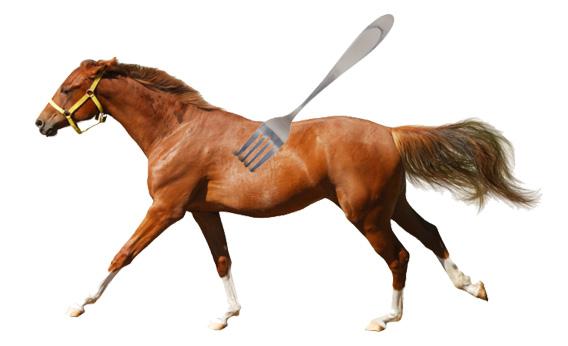Slaughtering horses for food has been prohibited in the United States since 2007, but animal rights advocates and ranchers continue to argue over the ban. A report (PDF) from the Government Accountability Office released in June says the prohibition merely shifted horse slaughter abroad, where consumers aren’t so squeamish about equine dining. Why don’t Americans eat horse?
Because we love our beasts of burden. As with many food taboos, there’s no settled explanation for why most Americans are perfectly willing to eat cows, pigs, and chickens but turn their noses up at horse. Horse-eating, or hippophagy, became popular in Europe in the 19th century, when famines caused several governments to license horse butcheries. Today, horse meat is most widely available in France, Belgium, and Sweden, where it outsells mutton and lamb combined. While Americans have occasionally consumed their equine friends during times of scarcity, the practice just didn’t catch on. It may be that so many Americans forged intimate relationships with horses during our founding and expansion that eating the creature seemed morally wrong by the time of the nation’s major food shortages of the 20th century.
Hippophagy may have become somewhat popular in industrial Europe, but it had been taboo there for at least a millennium before. We know because Pope Gregory III wrote a letter to Boniface, an eighth-century bishop in Germany, instructing him to eliminate the practice among pagan converts. The pope described hippophagy as a “filthy and abominable custom.” (Also, horses aren’t kosher.) The popular view among historians is that banning horse-eating helped distinguish Christians from the pagans, but some think the pope’s real motivation was to preserve horses for warfare. Around the same time, the Irish Collection of Canon law sought to end the Celtic and Teutonic habit of eating horse, forcing violators to subsist on bread and water for four years.
Americans looked on with curiosity as Europeans went back to horse meat in the 1800s. It had become so common by the end of the century that Scientific American published an article in 1892 remarking on the popularity of horse in France, the Netherlands, Germany, Sweden, Switzerland, and Milan. (Residents of Turin apparently hated the stuff.) While Americans wanted no part of hippophagy, they were perfectly willing to supply the raw materials. In 1899, the USDA engaged in a contentious exchange with a Norwegian paper that complained American inspectors rarely visited horse meat factories, because they didn’t sell domestically.
U.S. hippophagy seems to have reached its high point during and shortly after World War II, because of domestic shortages of other, more conventional meats. Horse steak was even on the menu at the Harvard faculty club, although ordinary Americans never fully embraced it. After publishing an article about the growing popularity of horse meat in 1943, Life got a series of pithy letters to the editor. One reader wrote: “If your illustrated article on horse meat is followed by one showing how to make chicken chitterlings, the meat problem will be solved. We’ll all be vegetarians.” Another responded: “Not this side of starvation. Not while there are beans.” (One hippophagy enthusiast suggested that the problem was horse doesn’t have a dinner table euphemism like “beef” or “pork.”)
Some horse-eaters say the meat tastes like beef, only slightly sweeter and more tender. (Other gourmets are less impressed.) During a meat shortage in 1946, American housewives reportedly tried to fool their husbands by swapping the cheaper and more widely available horse for beef.
Bonus Explainer: Is horse meat good for you? It’s a little better than beef. A three-ounce serving of roast horse has 149 calories, 24 grams of protein, and five grams of fat. The same amount of beef tenderloin has 179 calories, 24 grams of protein, and nine grams of fat. Horse milk, which some Central Asians drink in fermented form, has one-third the fat of cow’s milk.
Got a question about today’s news? Ask the Explainer.
Explainer thanks Richard Bulliet of Columbia University and Adrienne Hall of Drexel University.*
Correction, Oct. 25, 2011: This article originally misspelled the first name of Adrienne Hall.
